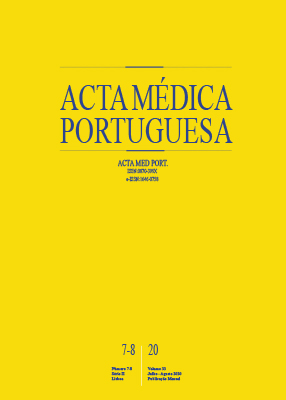Congenital Heart Disease Prevalence in Portugal in 2015: Data from the National Register of Congenital Anomalies
DOI:
https://doi.org/10.20344/amp.12111Keywords:
Heart Defects, Congenital / epidemiology, Portugal, RegistriesAbstract
Introduction: The prevalence at birth of congenital heart disease in Portugal is 8.3/1000 births; undetected critical congenital heart disease may result in adverse outcomes for the fetus/newborn infant. This study describes the reported cases of congenital heart disease in Portugal in 2015 regarding antenatal diagnosis, cardiac defect, and presence of other congenital anomalies/chromosomal abnormalities. These indicators are compared in live births and medical pregnancy terminations. Additionally, postnatal deaths were characterized.
Material and Methods: Congenital heart disease data derived from the 2015 Portuguese National Registry of Congenital Birth Defects were analyzed. The prevalence rates per 1000 births were assessed by the chi-square test of independence.
Results: The prevalence of congenital heart disease in this study was 5/1000 live-births (339 live-births, 20% with critical defects). The most common defects were ventricular septal defect (38%), atrial septal defect (15%), aortic coarctation (7%), tetralogy of Fallot (7%) and pulmonary stenosis (5%). One third of the live births had antenatal diagnosis of congenital heart disease. In the live-births with critical congenital heart disease, 54% had antenatal diagnosis and 14% were diagnosed at birth. There were records of 84 pregnancy terminations; 49% had critical defects, 75% had non-cardiac congenital anomalies and 40% had chromosomal abnormalities. There were 15 postnatal deaths recorded (3.4% mortality rate), associated with prematurity/low birthweight, critical congenital heart disease, other non-cardiac congenital anomalies and chromosomal abnormalities.
Discussion: The data analysis revealed a prevalence of congenital heart disease in this study of 5/1000 births (inferior to other international studies), with a distribution per type of anomaly similar to that reported in previously published work. There were significant regional differences that need further studying.
Conclusion: These results are paramount to characterize the Portuguese scenario and improve Healthcare planning. It is important to improve reporting in the Portuguese National Registry of Congenital Birth Defects.
Downloads
Downloads
Published
How to Cite
Issue
Section
License
All the articles published in the AMP are open access and comply with the requirements of funding agencies or academic institutions. The AMP is governed by the terms of the Creative Commons ‘Attribution – Non-Commercial Use - (CC-BY-NC)’ license, regarding the use by third parties.
It is the author’s responsibility to obtain approval for the reproduction of figures, tables, etc. from other publications.
Upon acceptance of an article for publication, the authors will be asked to complete the ICMJE “Copyright Liability and Copyright Sharing Statement “(http://www.actamedicaportuguesa.com/info/AMP-NormasPublicacao.pdf) and the “Declaration of Potential Conflicts of Interest” (http:// www.icmje.org/conflicts-of-interest). An e-mail will be sent to the corresponding author to acknowledge receipt of the manuscript.
After publication, the authors are authorised to make their articles available in repositories of their institutions of origin, as long as they always mention where they were published and according to the Creative Commons license.









